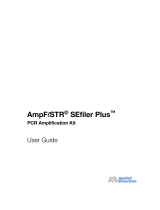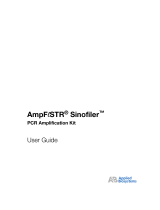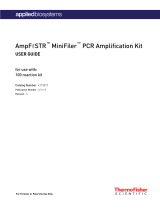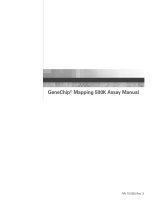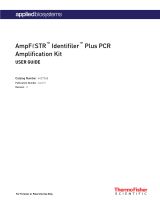Page is loading ...

Gene Amp In Situ
PCR System 1000
User’s Manual

© Copyright 2002, Applied Biosystems. All rights reserved.
For Research Use Only. Not for use in diagnostic procedures.
Printed in the United States of America. Software programs are protected by copyright. It is unlawful to duplicate these
programs in any manner other than for the user’s personal use. Specifically, it is unlawful to use or duplicate these programs
other than for use with the purchaser’s original computer.
Notice
The information contained in this document is subject to change without notice.
Applied Biosystems MAKES NO WARRANTY OF ANY KIND WITH REGARD TO THIS MATERIAL, INCLUDING,
BUT NOT LIMITED TO, THE IMPLIED WARRANTIES OF MERCHANTABILITY AND FITNESS FOR A
PARTICULAR PURPOSE. Applied Biosystems shall not be liable for errors contained herein or for incidental
consequential damages in connection with the furnishing, performance, or use of this material.
Copyright Information
Reproduction or publication of this document in any form or format is prohibited without written permission of Applied
Biosystems.
Part No. 0993-6006 Rev. C
Trademarks
ABI PRISM and its design, Applied Biosystems, AmpliCover and MicroAmp are registered trademarks of Applera
Corporation or its subsidiaries in the U.S. and certain other countries.
AmpliTaq and GeneAmp are registered trademarks of Roche Molecular Systems, Inc. and E. Hoffmann-La Roche AG.
The GeneAmp PCR Process, Taq DNA Polymerase, and AmpliTaq DNA Polymerase are covered by U.S patents owned by
Roche Molecular Systems, Inc., and issued and pending patents owned by E. Hoffmann-La Roche AG.
Epson is a trademark of Seiko Epson Corporation.
Registered trademarks, etc. used in this document even when not specifically marked as such, are protected by law.
AUTHORIZED THERMAL CYCLER NOTICE
This instrument, Serial No. ,________ is an Authorized Thermal Cycler. Its purchase price includes the up-front fee
component of a license under the patents of the Polymerase Chain Reaction (PCR) process, which are owned by Roche
Molecular Systems, Inc. and F. Hoffmann-La Roche Ltd., to practice the PCR process for internal research and development
using this instrument. The running royalty component of that license may be purchased from Applied Biosystems or
obtained by purchasing Authorized Reagents. This instrument is also an Authorized Thermal Cycler for use with
applications licenses available from Applied Biosystems. Its use with Authorized Reagents also provides a limited PCR
license in accordance with the label rights accompanying such reagents. Purchase of this product does not itself convey to
the purchaser a complete license or right to perform the PCR process. Further information on purchasing licenses to practice
the PCR process may be obtained by contacting the Director of Licensing at Applied Biosystems, 850 Lincoln Centre Drive,
Foster City, California 94404.

Contents
Preface: Using the Manual
Using the Manual P-1
Conventions P-3
Software Conventions P-3
Users Manual Summary P-4
Difference Between the DNA Thermal Cyclers and the GeneAmp
In Situ
PCR System 1000 P-6
Setting Cycle Hold Times and Temperatures P-6
Technical Support P-8
Chapter 1. The In Situ PCR Reagent Containment System
The Polymerase Chain Reaction (PCR) 1-2
In Situ
PCR 1-4
Requirements for
In Situ
PCR 1-4
The Applied Biosystems
In Situ
PCR Reagent Containment
System 1-6
AmpliCover Discs, AmpliCover Clips, and
In Situ
PCR Glass
Slides 1-6
The Assembly Tool 1-9
Chapter 2. Introducing GeneAmp In Situ PCR System 1000
Instrument Description 2-2
GeneAmp
In Situ
PCR System 1000 Software 2-5

Contents-2
Contents
System Files 2-5
Soak File (# 1) 2-6
Time Delay File (#2) 2-7
Step-Cycle File (#4) 2-8
Thermo-Cycle File (#3) 2-9
Configuration and Diagnostic Files 2-11
Creating User Files 2-12
Linking User Files – Creating Methods 2-12
System File Directory 2-12
Accessing the System Software 2-13
Chapter 3. Installing the GeneAmp In Situ PCR System 1000
Unpacking 3-2
Laboratory Requirements 3-3
Sample Block Cover 3-3
Grounding and Electrical Safety 3-3
Temperature, Humidity, and Environment 3-4
Connecting Electrical Power 3-4
Checking the Cooling and Heating Systems 3-5
Checking the Cooling System 3-5
Checking the Heating System 3-6
Installing a Printer 3-9
Installing the 120 V Printer 3-9
Installing the 240 V Printer 3-13
Configuring the GeneAmp In situ PCR System 1000 3-15

Contents-3
Contents
Chapter 4. Tutorial: Customizing In Situ PCR Files and Creating a
PCR Method
Goals of this Tutorial 4-2
Starting the Instrument 4-4
Overview of the Tutorial 4-5
Customizing the Soak Files 4-7
Customizing the Step-Cycle Files 4-10
Review of what you have learned so far 4-18
File Numbers 4-18
Summary of the Tutorial 4-19
Starting the Optional Hot Start Soak File and
In Situ
PCR
Method 4-21
Starting the optional Hot Start Soak File 4-21
Chapter 5. Preparing the Slides for In Situ PCR
Checking the Location of Samples on the Slide 5-2
Before You Begin Preparing the Slides 5-7
Processing the Slides 5-12
Loading the Slides 5-20
Starting the Run 5-22
Removing the AmpliCover Clips and Discs 5-26
Chapter 6. Running Samples for In Situ PCR: Run-Time Displays
Beginning a Run 6-2
Using the Start Key 6-2
Selecting the RUN Option 6-3
The Run-Time Displays 6-5
Soak File Run-Time Display 6-5
Time Delay File Run-Time Displays 6-6
Cycle Files Run-Time Displays 6-7
Sample Temperature Display 6-8

Contents-4
Contents
Pausing a Run 6-9
Aborting a Run 6-10
Run-Time Print Options 6-12
Chapter 7. Maintenance
Cleaning the Slide Sample Block 7-2
Cleaning Exterior Surfaces 7-2
Temperature Calibration Verification Test 7-2
Equipment Required 7-2
Test Results 7-6
Temperature Uniformity Test 7-8
Equipment Required 7-8
Test Results 7-12
Chapter 8. Troubleshooting
Instrument Troubleshooting Information 8-2
If the Instrument Turns Off 8-3
Chapter 9. Specifications
Part 1: GeneAmp
In Situ
PCR System 1000 Thermal Cycler
Specifications 9-1
Dimensions and Weight 9-1
The Sample Block 9-2
Slides 9-2
Power Requirements 9-3
Fuses 9-3
Control Panel 9-3
Display 9-3
Keypad 9-4
Indicator Lights 9-4
Block Temperature Range 9-4
Static Block Temperature Uniformity 9-4

Contents-5
Contents
Dynamic Block Temperature Uniformity 9-4
Ramp Time Reproducibility 9-5
Block Temperature Accuracy 9-5
Block Temperature Overshoot and Undershoot 9-6
Ramp Rate 9-6
Printer Interface 9-7
Software 9-7
Temperature Calibration 9-7
Part 2: Assembly Tool Specifications 9-8
Dimensions and Weight 9-8
Assembly Tool Platform Surface 9-8
Assembly Tool Power Requirements 9-9
Indicator Lights 9-9
Time Required to Reach Preset Temperature 9-9
Temperature Accuracy 9-9
Temperature Calibration 9-9
Appendix A: The Time-Delay and Thermo-Cycle Files
The Time Delay File #2 A-2
Customizing the Time-Delay File A-3
The Thermo-Cycle File #3 A-6
Customizing the Thermo-Cycle File A-8
Appendix B: The Demonstration File Parameters
Demonstration Files B-2
Appendix C: The Configuration and Diagnostic Files
Accessing the Configuration and Diagnostic Files C-2
Editing the Configuration File C-3
The Diagnostic File C-7
Accessing the Diagnostic Tests C-7
The Display/Keypad Test (Test #1) C-8

Contents-6
Contents
Delete User Files (Test #2) C-9
Heater Test (Test #3) C-10
The Chiller Test (Test #4) C-12
The Overshoot Test (Test #5) C-14
The Undershoot Test (Test #6) C-16
Appendix D: The File Directory
Using the File Directory D-3
Viewing a Directory of All Files D-4
Viewing a Directory Grouped by File Type D-5
Printing the Parameters of a File D-6
Deleting a File D-7
Using the FILE and CLEAR Keys D-7
Overwriting a File D-8
Appendix E: Using the Keyboard
Using the Keypad E-2
The START Key E-2
The STEP Key E-2
The HELP Key E-3
The STOP Key E-4
The FILE Key E-4
The YES Key E-5
The NO Key E-6
The ENTER Key E-6
The CLEAR Key E-6
The Numeric Keys E-7
Entering Negative Temperatures E-7

Contents-7
Contents
Illustrations
Figure P-1 Heating ramps on the DNA Thermal Cycler and
DNA Thermal Cycler 480 and the GeneAmp
In
Situ
PCR System 1000. P-7
Figure 1-1 PCR Process. 1-3
Figure 1-2
In Situ
PCR Reagent Containment System
Components. 1-7
Figure 1-3 The Assembly Tool. 1-10
Figure 2-1 Components of the GeneAmp
In Situ
PCR Sys-
tem 1000 (120V Model). 2-3
Figure 2-2 Slide, with AmpliCover Disc and Clip attached, in
one of the slots of the GeneAmp
In Situ
PCR Sys-
tem 1000. 2-4
Figure 2-3 Diagram of a Soak File. 2-6
Figure 2-4 Diagram of a Time Delay File. 2-7
Figure 2-5 Diagram of a Three-Temperature Step-Cycle
File. 2-8
Figure 2-6 Diagram of a Three-Temperature Thermo-Cycle
File. 2-10
Figure 2-7 Control Panel Keypad and Display. 2-13
Figure 2-8 Accessing the Main Software Functions. 2-14
Figure 2-9 Summary of Keyboard Functions. 2-15
Figure 3-1 DIP switch settings on the Epson 082302 serial
interface card. 3-10
Figure 3-2 Side panel of the GeneAmp
In Situ
PCR System
1000 and rear panel of the printer showing the
DIP switch settings and cable connections. 3-12
Figure 4-1 Linking Files to create a Method. 4-3
Figure 5-1 Slide Template and Tissue/Cell Spot Areas (To
Scale). 5-3
Figure 5-2 Area that is amplified when samples are off-
center. 5-4
Figure 5-3 Area between adjacent samples that will not be
amplified. 5-5

Contents-8
Contents
Figure 5-4 Area where AmpliCover Clips and Discs can be attached when
there are fewer than three samples. 5-6
Figure 5-5 The Assembly Tool and top-down view of the platform
surface. 5-13
Figure 5-6 Attaching the AmpliCover Clip and Disc to the slide. 5-17
Figure 5-7 Loading the slide Assemblies. 5-20
Figure 5-8 Positioning the slide on the Disassembly Tool. 5-27
Figure 5-9 Removing the AmpliCover Clip from the slide. 5-28
Figure 6-1 A run-time print-out of an incubation file. 6-13
Figure 6-2 A run-time cycle printout. 6-14
Figure 6-3 A run-time segment printout. 6-14
Figure 7-1 Inserting the RTD probe in the vertical slot. 7-4
Figure 7-2 Temperature measurements in the temperature calibration
verification test. 7-5
Figure 7-3 Calibration Label. 7-6
Figure 7-4 Positionlng of the RTD probe in toward the front of slot 1. 7-9
Figure 7-5 Temperature measurements in the temperature uniformity
test. 7-10
Figure 7-6 Positioning the RTD probe toward the back of slot 1. 7-11
Figure 7-7 Location of slots to be used in the Temperature Uniformity
Test. 7-12
Figure 9-1 Static and Dynamic block temperature uniformity while ramp-
ing up. 9-5
Figure 9-2 Block temperature overshoot after ramping up. 9-6

Safety and Regulatory
Information N
Symbols and Conventions Used in this Manual S
In this manual, the following graphic symbols and special text
formats are used to set apart important safety information.
! WARNING ! A warning indicates an operation that could
cause
personal injury
if precautions are not
followed.
CAUTION: A caution indicates an operation that could
cause
instrument damage
if precautions are not
followed.

S-2
Safety and Regulatory Information
Symbols and Conventions Used on the Instrument
There are three different types of symbols that appear on the
instrument.
This symbol indicates an operation (or condition on the
instrument) that could cause personal injury if precautions
are not followed. This can be any type of hazard.
When you see this symbol, refer to the safety pages in the
manual for further information.
Consulter les documents d’accompagnement.
If there is a hazard of heat or electric shock, the following caution
symbols will appear on the instrument:
This symbol indicates the danger of burns, if precautions are
not followed, due to the presence of heat in this area of the
instrument. There may also be hot surfaces that can be
easily touched.
Attention. Surface chaude.
This symbol indicates the danger of electric shock, if
precautions are not followed, due to the presence of high
voltage.
Attention. Risque de choc électrique.

S-3
Symbols and Conventions Used on the Instrument
Additional graphic symbols used on the instrument are the
following:
Indicates alternating current or voltage.
Indicates the primary protective grounding terminal.
Indicates the
off
position of the main power switch.
Indicates the
on
position of the main power switch.

S-4
Safety and Regulatory Information
Warnings on the
Assembly Tool
This section shows the label that is affixed to the Assembly Tool.
CAUTION: Hot Surface. Use care when working around this
area to avoid being burned by hot components
ATTENTION:Surface chaude.

S-5
Symbols and Conventions Used on the Instrument
Warnings on the
Instrument
The following sections present the labels affixed to the
instrument.
100/120/240 Volt Models The following labels are affixed to the front and side of the
instrument as shown in the figure below for all three voltage
models (100/120/240).
! WARNING ! DO NOT OPEN. See Instruction Manual.
! AVERTISSEMENT ! NE PAS OUVRIR. Consulter les documents
d’accompagnement.
CAUTION: Hot Surface. Use care when working around this area to avoid being
burned by hot components.
ATTENTION:Surface chaude.

S-6
Safety and Regulatory Information
100 Volt Model The following warning labels are affixed to the instrument for the
100 volt models as shown in the figure below.
! WARNING ! DISCONNECT SUPPLY CORD BEFORE OPENING.
GROUNDING CIRCUIT CONTINUITY IS VITAL FOR SAFE
OPERATION OF EQUIPMENT. NEVER OPERATE EQUIPMENT
WITH GROUNDING CONDUCTOR DISCONNECTED.
! AVERTISSEMENT ! DÉBRANCHER LE CORDON D’ALIMENTATION AVANT
D’OUVRIR. LA CONTINUITÉE DES MASSES EST
ESSENTIELLE POUR UN FONCTIONNEMENT SANS
DANGER. NE JAMAIS UTILISER L’ÉQUIPMENT SI LE
FIL DE TERRE N’EST PAS RACCORDÉ.
! WARNING ! FOR PROTECTION AGAINST FIRE HAZARD, REPLACE ONLY
WITH SAME TYPE AND RATING OF FUSE.
! AVERTISSEMENT ! AFIN D’ASSURER LA PROTECTION CONTRE LES
RISQUES D’INCENDIE, REMPLACER UNIQUEMENT
PAR UN FUSIBLE DE MÊME TYPE ET DE MÊME
COURANT NOMINAL.

S-7
Symbols and Conventions Used on the Instrument
120 Volt Model The following warning labels are affixed to the instrument for the
120 volt models as shown in the figure below.
! WARNING ! DISCONNECT SUPPLY CORD BEFORE OPENING. GROUNDIN
G
CIRCUIT CONTINUITY IS VITAL FOR SAFE OPERATION OF
EQUIPMENT. NEVER OPERATE EQUIPMENT WITH
GROUNDING CONDUCTOR DISCONNECTED.
! AVERTISSEMENT ! DÉBRANCHER LE CORDON D’ALIMENTATION AVANT
D’OUVRIR. LA CONTINUITÉE DES MASSES EST
ESSENTIELLE POUR UN FONCTIONNEMENT SANS
DANGER. NE JAMAIS UTILISER L’ÉQUIPMENT SI LE FI
L
DE TERRE N’EST PAS RACCORDÉ.
! WARNING ! FOR PROTECTION AGAINST FIRE HAZARD, REPLACE ONLY
WITH SAME TYPE AND RATING OF FUSE.
! AVERTISSEMENT ! AFIN D’ASSURER LA PROTECTION CONTRE LES
RISQUES D’INCENDIE, REMPLACER UNIQUEMENT
PAR UN FUSIBLE DE MÊME TYPE ET DE MÊME
COURANT NOMINAL.

S-8
Safety and Regulatory Information
220–240 Volt Model The following warning labels are affixed to the instrument for the
220–240 volt models as shown in the figure below.
! WARNING ! DISCONNECT SUPPLY CORD BEFORE OPENING.
GROUNDING CIRCUIT CONTINUITY IS VITAL FOR SAFE
OPERATION OF EQUIPMENT. NEVER OPERATE EQUIPMENT
WITH GROUNDING CONDUCTOR DISCONNECTED.
! AVERTISSEMENT ! DÉBRANCHER LE CORDON D’ALIMENTATION AVANT
D’OUVRIR. LA CONTINUITÉE DES MASSES EST
ESSENTIELLE POUR UN FONCTIONNEMENT SANS
DANGER. NE JAMAIS UTILISER L’ÉQUIPMENT SI LE
FIL DE TERRE N’EST PAS RACCORDÉ.
! WARNING ! FOR PROTECTION AGAINST FIRE HAZARD, REPLACE ONLY
WITH SAME TYPE AND RATING OF FUSE.
! AVERTISSEMENT ! AFIN D’ASSURER LA PROTECTION CONTRE LES
RISQUES D’INCENDIE, REMPLACER UNIQUEMENT
PAR UN FUSIBLE DE MÊME TYPE ET DE MÊME
COURANT NOMINAL.

S-9
Electromagnetic Compatibility (EMC)
Electrical Safety Testing
! WARNING ! Routine safety testing of analytical
instruments (e.g., high potential voltage
testing) may be required by various safety
agencies.
Testing should only be carried out by
qualified personnel after seeking advice
from Applied Biosystems.
Internal AC line surge suppressors may
need to be disconnected before a test is
performed. On completion of the tests, it is
essential to reconnect the surge
components.
Electromagnetic Compatibility (EMC) S
United States (FCC)
This product is classified as a digital device used exclusively as
industrial, commercial, or medical test equipment. It is exempt
from the technical standards specified in Part 15 of the FCC
Rules and Regulations, based on Section 15.103 (c).
Japan (FCC)
This equipment has been tested and found to comply with the
Ilimits for a Class A digital device, pursuant to Part 15 of the FCC
Rules. These limits are designed to provide reasonable protection
against harmful interference when the equipment is operated in a
commercial environment. This equipment generates, uses, and
can radiate radio frequency energy and, if not installed and used
in accordance with the instruction manual, may cause harmful
interference to radio communications. Operation of this
equipment in a residential area is likely to cause harmful
interference in which case the user will be required to correct the
interference at his own expense. Changes or modifications not

S-10
Safety and Regulatory Information
expressly approved by the manufacturer could void the user’s
authority to operate the equipment.
European Union (EMC Directive)
This product has passed the following EMC tests:
VDE 0871B
EN 55011 : 91
IEC 801–2 : 84
lEC 801–4 : 84
lEC 801–4 : 88
/




